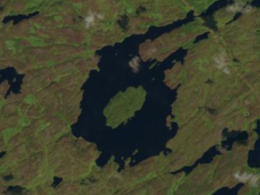|
Gow crater
Gow is an impact crater in Saskatchewan, Canada. It is 5 km (3 mi) in diameter and the age is estimated to be less than 250 million years (Triassic or later). The crater contains a classic crater lake (Gow Lake[1]) with an island (Calder Island) formed by the central uplift.[2][3] It is the smallest known crater in Canada with an uplift structure.[4] The crater is unique in that it is the only preserved example of a transitional impact structure on earth. This is characterized by a crater having relatively smooth walls and a floor partly or completely covered by debris slumped from the crater walls. The only other example existing is in Australia however is it extremely deteriorated. Due to this, the rock forming the crater bed is a unique form of breccia existing nowhere else on earth. This rock was formed when existing rock was liquified during the meteor impact. [5] The larger Deep Bay crater, of Cretaceous age, is approximately 90 kilometres (56 mi) east of Gow crater. The Carswell impact structure, also of Cretaceous age, is to the northwest of Gow. Gow LakeGow Lake — the lake that fills the crater — has a surface area of 1,744.4 hectares (4,311 acres) and a shoreline that is 47 kilometres (29 mi) long. Fish commonly found in the lake include burbot, lake trout, lake whitefish, northern pike, and walleye.[6][7] The lake, and by extension, the crater, were named after James Richard Gow. He was killed in action during World War II on 25 April 1945.[8] See alsoReferences
External links |
||||||||||||||||||||||||||




